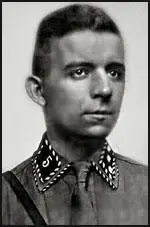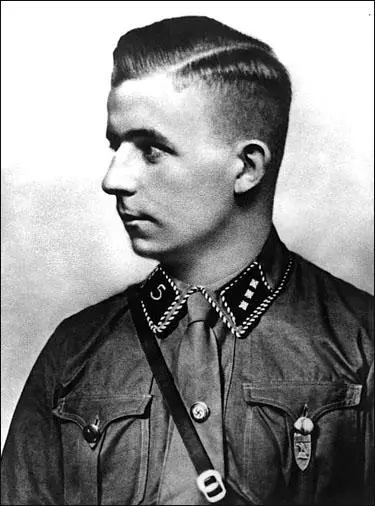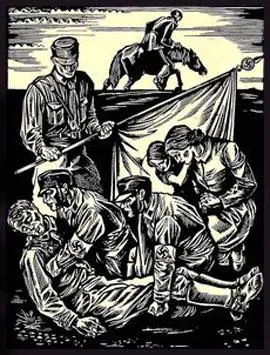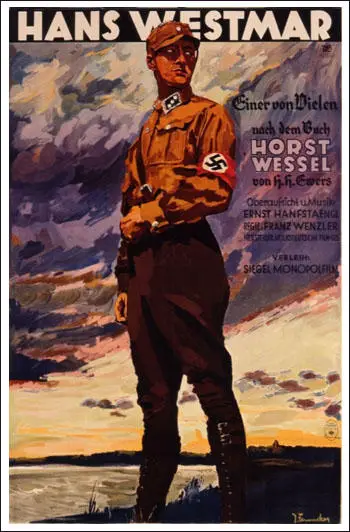Horst Wessel

Horst Wessel, was born in Bielefeld, Germany, on 9th October, 1907. His father, was a Lutheran minister at the St Nicholas Church in Berlin. He had a sister Ingeborg (born 19th May 1909) and Werner (born 22nd August 1910). The family lived in the Judenstraße, the Jewish sector of the city. (1)
As a young man joined several right-wing organizations. "Horst Wessel became the leader of a group called Crown Princess... It was not long before he was joining more sinister groups, the Viking, the infamous Organization Consul, and finally the Black Reichswehr. Most of the members had come back from the war desperate, defeated soldiers, completely lost in civilian life... Horst Wessel, who had been too young to go to war, was never more than adventurous loafer." (2)
In 1925 Wessel registered with the Friedrich Wilhelm University but soon began neglecting his studies. (3) According to Konrad Heiden, it was when Wessel was a student he broke with his family. In 1926 he joined the Nazi Party and became the leader of the Sturmabteilung (SA) in his neighbourhood: "Horst Wessel was the exact mixture of ruffian and idealist that constitutes the armed bohemian." (4)
Horst Wessel - SA Leader
Wessel's group provided protection for Adolf Hitler and other Nazi leaders when they made speeches in the city. Rudolf Olden was a journalist who reported on the SA behaviour at public meetings: "The SA began to terrorise entire cities... Meetings were announced on huge red placards, with terrific slogans. Lorry-loads of yelling young bullies, waving swastikas on a red background, would tear through the town, flinging handbills into the streets. Every entrance to the meeting was guarded by groups of these violent young men.... The Storm Troops march into hall with the monotonous even step of the Prussian battalions. A band commands silence. He appears, surrounded by a bodyguard of the tallest of his dangerous, and dangerous-looking, lads. He (Hitler) is greeted with the enthusiastic cries of well-practised supporters. Everything is done with a view to impressing newcomers and the half-converted; all is designed to fill the masses with the shudder of pleasure which a display of superior strength inevitably arouses in weak souls... Hitler... picked out bullies and rowdies, all of them young fellows with a natural leaning to violence." (5)
In August 1927, Horst Wessel and about 50 SA men marched from Berlin to the annual party rally in Nuremberg. He later wrote that the city resembled a "brown army camp". He claimed it was an experience he would never forget. On his return he was arrested for being a member of a prohibited organization. Joseph Goebbels wrote in Der Angriff: "You blond youth, if you have tears in your eyes, swallow them. Do not weep before these sorry figures of magistrates." (6)
Storm Unit 5
Goebbels was very impressed with Wessel and in January 1928, Goebbels sent Wessel to Vienna to study the organization and working methods of the city's National Socialist Youth Group. Wessel was then responsible for introducing a new secret cell system in Berlin. It has been argued that Wessel, the leader of Storm Unit 5, was "particularly aggressive in leading incursions into Communist territory and giving inflammatory speeches in an atmosphere of confrontation". (7)
Horst Wessel and his SA group targeted their violence on young members of the German Communist Party (KPD). Goebbels got involved in these fights and he wrote in his diary about a street brawl that took place on 23rd September, 1929: "Before my eyes clubs, daggers, brass knuckles appear. I feel a blow on my shoulder. As I turn to one side, a Communist takes aim at me. A shot rings out. Stones fly. Tonak (a SA friend) is already bleeding heavily. A wild volley of shots... I apply pressure to Tonak's wound. He starts up the car and drives off." (8)

In September 1929, Wessel met Erna Jänicke, an 18-year-old prostitute. He moved into her apartment in Große Frankfurter Straße. It has been claimed by Erika Mann that was Wessel was Jänicke's pimp. "While his mistress was making money, he was breaking up meetings and taking part in the bloody street fights between workers and Nazi toughs that were then so common". (9) However, historians such as William L. Shirer, have pointed out that Mann was a prominent anti-Nazi, and though this charge may have been exaggerated... he (Wessel) definitely consorted with pimps and prostitutes". (10)
In November, 1929, several members of the SA and the KPD were killed in street fighting. It was claimed that Wessel's gang was responsible for the murder of several men. KPD posters appeared with pictures of Wessel that had the caption: "Note that face! Horst Wessel Storm Leader - Murderer of Workers". (11)
On 28th December, 1929, Horst's brother, Werner Wessel, died in a skiing accident. Goebbels arranged a large public funeral for Werner, who was also a senior figure in the SA. Over 500 men with torches marched past the KPD's headquarters on the way to the cemetery. Goebbels wrote: "It was gripping and shattering. I could hardly speak." (12)
Death of Horst Wessel
Wessel's landlady was Elisabeth Salm, whose late husband had been an active Communist. After a few months, there was a dispute between Salm and Wessel over unpaid rent. She approached some of her former husband's friends in the KPD to help have Wessel removed from the apartment. Albrecht Höhler, a member of the Red Front Fighters' League, agreed to organize the eviction. (13)
On 14th January, 1930, while the eviction was taking place, Höhler shot Wessel in the face. Jänicke identified Höhler as the gunman and he was arrested. (14) The KPD claimed that the shooting had been motivated by a jilted pimp. Salm told journalists that the conflict was an example of "two men fighting over a retired tart". (15)
Joseph Goebbels visited Horst Wessel four times in hospital. He had survived an operation undertaken to stop the internal bleeding, but the surgeon had not managed to remove the bullet lodged in front of the cerebellum. Goebbels wrote in his diary that Wessel told him, "One has to keep going! I'm happy". (16)
Over the next few days there was a propaganda war in Berlin. The left-wing newspaper, Die Rote Fahne, argued that Wessel was a pimp and that Höhler had no connection with the KPD. (17) Goebbels dismissed this claim and he wrote in Der Angriff that the murderers were communists and they needed to be "crushed to a pulp". (18)

Horst Wessel died on 23rd February, 1930. Goebbels attempted to make the funeral the occasion of impressive mass demonstrations but the police refused to issue a permit. However, every attempt was made to get as many SA men on the streets as possible. Goebbels wrote in his diary that the funeral was attended by around 30,000 people. (19)
The coffin draped with a swastika flag was lowered into the grave. Goebbels spoke of Wessel as a "Christ like" figure whose deeds proclaimed, "Come unto me, I will redeem you... One man must be an example and offer himself as a sacrifice". Goebbels used Wessel as an example to other SA men. "Through sacrifice to redemption... through struggle to victory." Goebbels went on to say: "And when the SA assembles for the great roll call, when every man's name is called, the Führer will also call your name, Comrade Wessel! And all, all SA men will answer with one voice, Here!... Wherever Germany is, there you are as well, Horst Wessel!" (20) Communists carried banners saying "Wessel the Pimp" and the funeral was followed by street fighting. (21)
Nazi Hero
Wessel's mother gave Goebbels her son's papers. This included the song lyric, The Flag Held High, that had already been adopted by the Berlin SA. Like many Nazi songs, it was an existing tune with new words. The song was sung at Wessel's funeral and eventually became one of the most important features of Nazi Party meetings. (22)
Albrecht Höhler was found guilty of murder but was only sentenced to six years imprisonment for the shooting. The judge explained the light sentence by arguing that there were "extenuating circumstances" in the case. (23)
On 15th January, 1933, Goebbels a propaganda spectacle, a Festival of Remembrance for Horst Wessel. The march of SA men began from outside the German Communist Party (KPD) headquarters in Berlin and went to Wessel grave. (24) Horst's mother attempted to have a say in the commemoration of her son's death. Goebbels rejected the idea and wrote in his diary: "She is unbearable in her arrogance. Our dead belong to the nation." (25)
Adolf Hitler was appointed as Chancellor on 30th January 1933. A general pardon for crimes committed during the "seizure of power" was issued on 21st March 1933. In contrast, two communists from Dortmund, who had been sentenced to prison for stabbing an SA man, was retried and executed. Soon afterwards a group of SA men dragged Höhler from his cell and he was murdered in a forest outside Berlin. (26)
In October, 1933, the film Horst Wessel, was ready for release. It was immediately banned by Goebbels. He explained in an interview in Der Angriff that any film made about "the National Socialist idea" must be of "absolutely first-class artistic quality" and that a film about Horst Wessel was even more important than others made depicting the SA. He argued that the figure of Horst Wessel as portrayed in the film did not approach the character of the man in reality. (27)
Ernst Hanfstaengel who was involved in the making of the film later recalled: "It was too bourgeois in approach, emphasized Horst Wessel's Christian background too much, was not full of the National Socialist revolutionary spirit, was trite - everything was wrong." (28) Hanfstaengel, who was one of Hitler's old friends, eventually managed to apply considerable pressure on Goebbels. After the director agreed to make some cuts the film was reissued under the name Hans Westmar: One of the Many. (29)

Toby Thacker, the author of Joseph Goebbels: Life and Death (2009) has argued: "Only after many cuts had been made, and the direct reference to events in Wessel's life had been removed, was the film reissued... In its synthesis of a heroic personal narrative, the funeral ceremony, and stirring music, the cult of Horst Wessel embodied all the elements most central to Goebbels' propaganda, the cult of sacrifice, the overtones of religion, and the centrality of death." (30) It has been pointed out that Joseph Goebbels used this row to convince Adolf Hitler that he should have control over the German film industry. (31)
All schools in Nazi Germany taught about Horst Wessel and other martyrs for the Nazi cause. Erika Mann recorded: "Nazi school children know Horst Wessel as a heroic, saintly figure of light, a godlike hero hated by the enemies of the Nazis, a man who sacrificed his life in the battle against evil. His song, they are told - and they have not so much as a suspicion that the accuracy of what they are taught is doubtful - is one of the greatest creations of the German spirit. And they sing it lustily." (32)
The song, The Flag Held High, that Horst Wessel had written in 1929 became the anthem of Nazi Germany, the Horst-Wesset-Lied. Toby Thacker has pointed out: "With its four-square tempo it worked as a marching song; emotionally it combined a degree of solemnity with triumphalism, which made it perfect for Nazi ceremonies. It could be performed effectively by voices alone, but gained in power if accompanied by a military band or a full orchestra." (33)
Primary Sources
(1) Erika Mann, School for Barbarians (1938)
Horst Wessel, a national hero in the new Germany, was the son of a North German pastor, a chaplain during the War. This man, whose name-song is the national anthem now, was always fond of playing soldiers, of handling daggers and revolvers; his intelligence was definitely below normal, and he never could find his way into a civil profession. Still at school age, he joined one of the quasi-military organizations which were springing up, German nationalist in character, and composed of young men with nothing better to do who gathered in the hope that the War might yet be won. Horst Wessel became the leader of a group called Crown Princess, affiliated with the rather childish Bismarck Bund. It was not long before he was joining more sinister groups, the Viking, the infamous Organization Consul, and finally' the Black Reichswehr.
Many of the members had come back from the War desperate, defeated soldiers, completely lost in civilian life. Some went to Silesia or the Baltic region in the hope of rescuing lost German territory; but Horst Wessel, who had been too young to go to war, was never more than an adventurous loafer. The organizations, moreover, were losing their purely nationalist character and degenerating into bands of terrorists.
The National Socialist movement, in its attempt to gather power, gathered in the debris of these Freikorps, becoming their successor; Horst Wessel became a Nazi. To appease his relatives and the world in general, he decided to attend a university; but he never was even a Bummel student (a chronic student, behaving as though the academic life were a profession), for he hardly set eyes on a university. He was living in one of the most disreputable sections of Berlin, and engaging in a more remunerative profession. The pastor's son was living with a notorious whore, and earning money as procurer. But the Nazis made sure that he would not forget his appetite for playing soldier. While his mistress was making money, he was breaking up meetings and taking part in the bloody street fights between workers and Nazi toughs that were then so common. During one of those brawls, Horst Wessel was killed.
He had never worked in his life. He had been a degenerate who never accomplished a thing that can be counted in his favor. But he has become the national hero of Germany, and his song, Die Fahne Hoch (Up with the Flag) the national hymn...The hero and martyr of Hitler's regime died as a notorious pimp; the "National Hymn," his life work, is not only a plagiarism, but a clumsy one.
However, Nazi school children know Horst Wessel as a heroic, saintly figure of light, a godlike hero hated by the enemies of the Nazis, a man who sacrificed his life in the battle against evil. His song, they are told - and they have not so much as a suspicion that the accuracy of what they are taught is doubtful - is one of the greatest creations of the German spirit. And they sing it lustily.
(2) Toby Thacker, Joseph Goebbels: Life and Death (2009)
Goebbels directed all his propaganda methods onto the mythologization of Horst Wessel. He described him as a "Christ-socialist" in Der Angriff, and presented there a narrative of Wessel's life which explicitly drew on the tropes of the Passion. In one of several emotional articles...
Shortly after Wessel's death Goebbels was given his "political diary" by Wessel's mother, and this provided him with copy for further articles in Der Angriff. Wessel had left another testimony in the form of a song, Die Fahne hoch (The Flag Held High). This hymn-like march song, which became the anthem of Nazi Germany, the Horst-Wesset-Lied, had in fact been adopted by the Berlin SA months before Wessel's death. Like many Nazi songs, it was an existing tune with new words. Earlier in September 1929 Goebbels had been sufficiently struck by the song at a meeting to make a special note, and he took to using its first line, `Die Fahne hoch!', as an expression of commitment in his diary, and at the end of articles in Der Angriff, rather as years before he had written Sieg und Heil! The song was printed in Der Angriff in September 1929, and its popularity quickly spread outside Berlin. It was sung at the set-piece of Wessel's funeral on 1 March 1930, a turbulent ceremony conducted amongst large crowds of hostile Communists.
On the same day, the words of the song were printed on the front page of the Volkischer Beobachter, under the title "Horst Wessel's greeting to the coming Germany". This was the song Goebbels had been looking for which could act as an anthem for the movement. With its four-square tempo it worked as a marching song; emotionally it combined a degree of solemnity with triumphalism, which made it perfect for Nazi ceremonies. It could be performed effectively by voices alone, but gained in power if accompanied by a military band or a full orchestra. By May 1930 it had become part of Nazi ritual to close every meeting with a communal rendering of Wessel's song.
Student Activities
Adolf Hitler's Early Life (Answer Commentary)
Adolf Hitler and the First World War (Answer Commentary)
Adolf Hitler and the German Workers' Party (Answer Commentary)
Sturmabteilung (SA) (Answer Commentary)
Adolf Hitler and the Beer Hall Putsch (Answer Commentary)
Adolf Hitler the Orator (Answer Commentary)
An Assessment of the Nazi-Soviet Pact (Answer Commentary)
British Newspapers and Adolf Hitler (Answer Commentary)
Lord Rothermere, Daily Mail and Adolf Hitler (Answer Commentary)
Adolf Hitler v John Heartfield (Answer Commentary)
The Hitler Youth (Answer Commentary)
German League of Girls (Answer Commentary)
Night of the Long Knives (Answer Commentary)
The Political Development of Sophie Scholl (Answer Commentary)
The White Rose Anti-Nazi Group (Answer Commentary)
Kristallnacht (Answer Commentary)
Heinrich Himmler and the SS (Answer Commentary)
Trade Unions in Nazi Germany (Answer Commentary)
Hitler's Volkswagen (The People's Car) (Answer Commentary)
Women in Nazi Germany (Answer Commentary)
